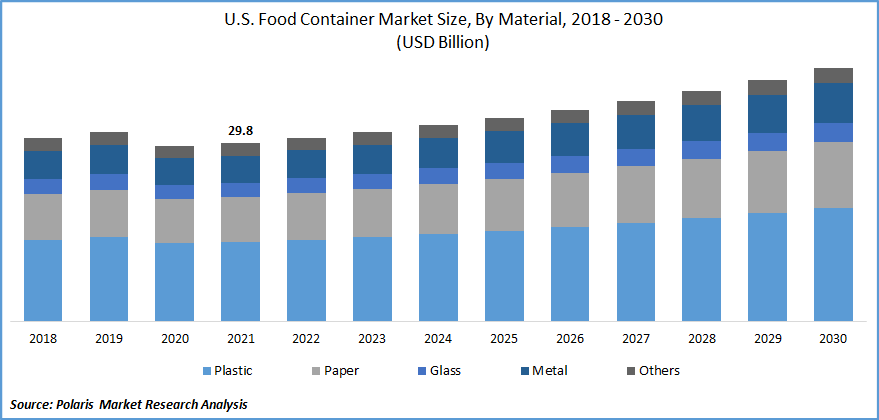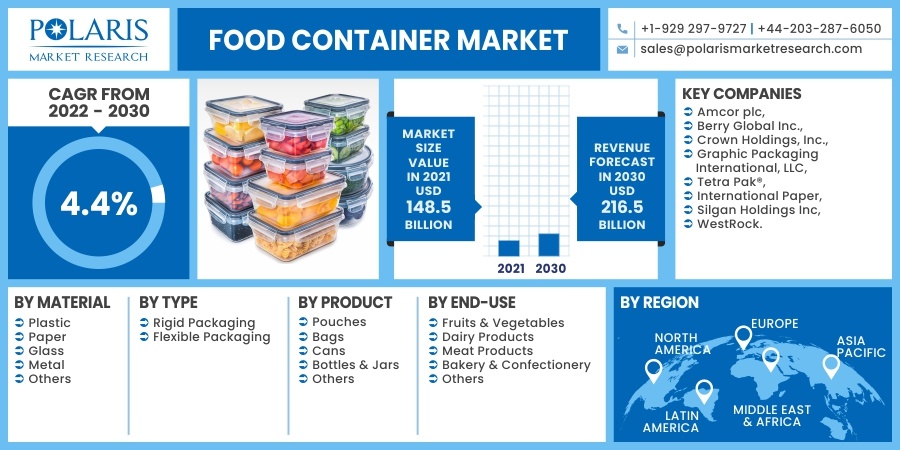
Food Container Market Share, Size, Trends, Industry Analysis Report, By Material (Plastic, Paper, Glass, Metal, Others); By Type (Rigid Packaging, Flexible Packaging); By Product; By End-Use; By Region; Segment Forecast, 2022 - 2030
- Published Date:Apr-2022
- Pages: 101
- Format: PDF
- Report ID: PM2361
- Base Year: 2021
- Historical Data: 2018 - 2020
Report Summary
The global food container market was valued at USD 148.5 billion in 2021 and is expected to grow at a CAGR of 4.4% during the forecast period. The rising trend of convenience food in the market is increasing at a significant pace, which is likely to drive the demand for containers. Convenience food is any eatable that is ready-to-eat and requires less preparation or none at all. It helps consumers prepare and cook healthy meals in no time that contains all the fresh nutrients. These are used to shorten the time of meal preparation at home. There are some convenience foods that can be eaten immediately or after adding some water or heating.
 Know more about this report: request for sample pages
Know more about this report: request for sample pages
Supermarkets, hypermarkets, and local stores are competing for such customers that need convenience foods in everyday life. At the same time, online deliveries are also expanding due to the rising demand for ready-to-eat eatables which is expected to augment the growth of the food container market in the near future.
The container market faced a negative impact from the COVID-19 pandemic. Lockdowns and stringent regulations in countries around the world resulted in a decline in demand for food packaging. During the pandemic, various industries were considered essential and were never shut down completely, including the food & beverage and packaging industry. However, these industries faced a significant impact owing to the rising and declining demand for food and related products.

Know more about this report: request for sample pages
Industry Dynamics
Growth Drivers
The development of packaging systems such as intelligent packaging, vacuum packaging, active packaging, edible coating, and others increases the shelf life and provides better and quality food to the consumers which are expected to propel the growth of the container market. Intelligent packaging is a type of packaging system where a class of packaging material can make the customer aware of the condition of the packaged eatables or the food environment inside the package through detecting, sensing, tracing, etc. This system is broadly classified into three categories: sensors, indicators, and radiofrequency identification (RFID) systems.
Active packaging is a kind of packaging system where the constituent is either added in the headspace or included within the packaging material that helps preserve food safety, quality and shelf life. Vacuum packaging is a method of removing air from the package to provide longer shelf life for the consumables. It is considered a form of Modified Atmosphere Packaging (MAP). The proper vacuum bags can reduce freezer burn. It is a widely chosen form of packaging for meat storage across the globe.
Report Segmentation
The market is primarily segmented based on material, type, product, end-use, and region.
|
By Material |
By Type |
By Product |
By End-Use |
By Region |
|
|
|
|
|
Know more about this report: request for sample pages
Insight by Material
The plastic segment accounted for 36.92% of the global container market in 2021 in terms of revenue. The demand for food containers is expected to rise as plastics are extensively used in bakery food, meat products, dairy products, fruits & vegetables, and others, owing to the larger benefits that it offers. This type of packaging saves energy and requires less fuel for the transportation of goods.
Paper packaging is made up of paper materials used to store and transport goods. Roll paper is used as a raw material for paper packaging. Paper is kept into the corrugated machine to make sheet paper followed by various stages to finally get carton packages.
The metal segment is expected to witness growth as metal provides premium packaging solutions to cater to the needs of various end-users. It offers a total barrier against gas, light, and oxygen and withstands extreme temperatures and pressure. Such packaging is extensively used in food & beverage industry as it provides good barrier properties and extended shelf life to the consumable products.
Insight by Type
Rigid Packaging comprises stronger and heavier materials than flexible packaging, including metals, cardboards, glasses, cans, jars, hard plastic cannabis containers, yogurt containers, wine bottles, and hummus containers, and others. Owing to its higher protection capabilities, it is widely used in the container market.
Flexible packaging is economical and customizable and is constructed using a combination of materials such as plastic film, paper, foil, paperboard, pouches, sachets, bags, and others. It serves various benefits, including improved production efficiency, enhanced product life, creative packaging designs, easy handling, and eco-friendly.
Flexible packaging needs less water and energy to manufacture and transport and generates small quantities of greenhouse gases on its way to market, which is expected to drive the demand for flexible packaging, further driving the growth of the container market.
Insight by Product
The bags segment accounted for over 26% of the food container market in 2021. A bag is a flexible container made up of thin plastic or paper used for storing, holding, and carrying products. Paper bags and plastics bags are extensively used across the globe for the packaging of various eatable products, including fruits and vegetables, frozen foods, bakery & confectionery goods, and meat & meat-related products. Various types of pouches include stand-up pouches, flat pouches, twin pouch, gussets, corner spouts, etc. All these pouches are used for the packaging of different eatable items depending on the various properties it offers.
Vacuum pouches are most commonly used, which are made from a combination of nylon and polythene, which are used for keeping food such as meat or seafood, dried consumables, baked goods, etc. This type of packaging provides barrier protection against atmosphere and moisture.
The container market is largely driven by the demand for cans owing to its various properties such as barrier protection against air, water, and light and preventing leakages and spoilage during transportation. Cans packaging is widely used in the food & beverage industry as they are less fragile than glass and stronger than paper. They preserve the food from deterioration and maintain the flavors and nutritional food value of the packaged products.
Geographic Overview
The demand for food containers is projected to grow owing to their greater use in the food & beverage industry. North America is one of the largest producers and exporters of fruits & vegetables across the globe. The meat and poultry sector also accounts for a significant share in the North American market, which is expected to augment the growth of containers used in the packaging of meat and meat-related products.
Germany is one of the largest markets for food & beverages in the European Union. In 2019, Germany produced an estimated USD 221.7 billion of processed eatables and drinks. Nuts, dried fruits, fish and seafood products, bakery products, sweet potatoes, organic products, and pulses witness good sales in the German market, which is expected to augment the demand for the food container market.
Asia Pacific is expected to account for a significant share of the container market over the forecast period. The proliferation of the e-commerce market, rising urbanization, changes in consumers’ eating preferences, and the increasing disposable income level of people in developing economies of the region and their spending capabilities are the factors projected to contribute to the growth of the container market.
Competitive Insight
Amcor plc is a global packaging manufacturer that focused on investing for organic growth in the most attractive segments, accelerating innovation, commercializing more sustainable product platforms, and integrating the Bemis acquisition. International Paper, a global leader has adopted the strategy of acquisition and collaboration to maintain a strong position in the global container market. It has acquired two corrugated packaging businesses in the Madrid and Catalonia regions in Spain in order to grow its presence in the two largest industrial regions in the country.
Food Container Market Report Scope
|
Report Attributes |
Details |
|
Market size value in 2021 |
USD 148.5 billion |
|
Revenue forecast in 2030 |
USD 216.5 billion |
|
CAGR |
4.4% from 2022 to 2030 |
|
Base year |
2021 |
|
Historical data |
2018 - 2020 |
|
Forecast period |
2022 - 2030 |
|
Quantitative units |
Revenue in USD billion and CAGR from 2022 to 2030 |
|
Segments covered |
By Material, By Type, By Product, By End-Use, By Region |
|
Regional scope |
North America, Europe, Asia Pacific, Latin America; Middle East & Africa |
|
Key companies |
Amcor plc, Berry Global Inc., Crown Holdings, Inc., Graphic Packaging International, LLC, Tetra Pak®, Graphic Packaging International LLC, Tetra Pak®, International Paper, Silgan Holdings Inc, WestRock. |
License and Pricing
Purchase Report Sections
- Regional analysis
- Segmentation analysis
- Industry outlook
- Competitive landscape
Connect with experts
Suggested Report
- Global Anti-Snoring Devices and Snoring Surgery Market Research Report, Size, Share & Forecast by 2018 - 2026
- Drone Logistics and Transportation Market Share, Size, Trends, Industry Analysis Report, 2022 - 2030
- Breast Lesion Localization Methods Market Research Report, Size, Share & Forecast by 2018 - 2026
- Microfiltration Membranes Market Share, Size, Trends, Industry Analysis Report, 2022 - 2030
- Protein Bar Market Share, Size, Trends, Industry Analysis Report, 2022 - 2030

